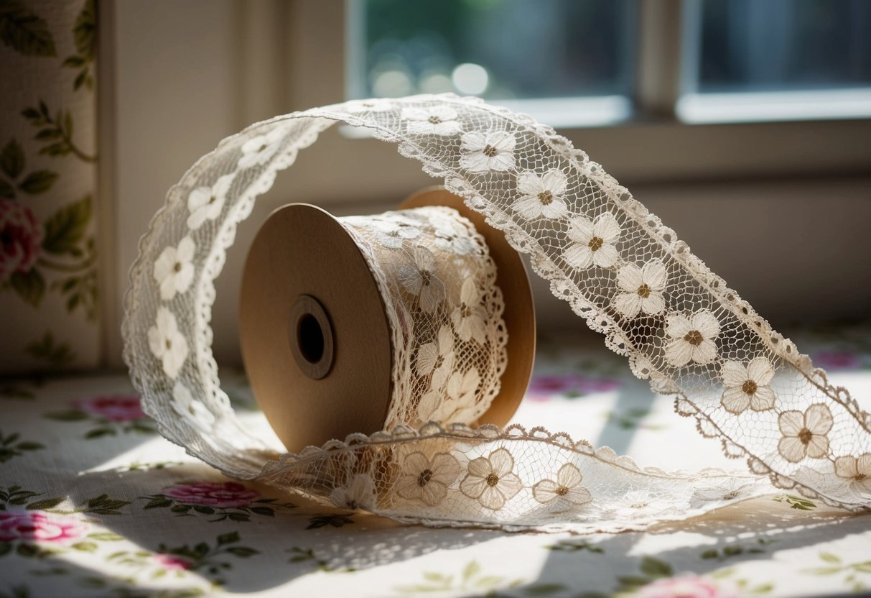Unraveling the delicate intricacies: From traditional cotton to modern synthetic blends and everything in between
Lace fabric stands as one of the most elegant and versatile materials in fashion and design. Lace-making techniques range from delicate handcrafted methods to modern machine production, creating intricate patterns that add beauty to clothing, accessories, and home décor.
The charm of lace lies in its detailed patterns and open weave design. From romantic wedding gowns to vintage-inspired fashion, lace adds a touch of sophistication to any piece. Its weight typically varies between 40-180 GSM, making it suitable for various uses.
Traditional lace craftsmanship spans centuries and continents, with notable production centres in Italy, Flanders, and China. Today’s lace combines these time-honoured methods with modern innovations, offering endless possibilities for creative expression.
On This Page
Key Takeaways
- Lace comes in numerous styles and weights suitable for both fashion and home décor
- Modern production methods blend traditional craftsmanship with innovative techniques
- Quality lace requires proper care and maintenance to preserve its delicate patterns
The History of Lace
Lace emerged from humble beginnings as a functional trim and evolved into a symbol of wealth and refinement across Europe. The craft developed from simple knotted threads into complex patterns that required immense skill and countless hours to create.
Origins and Evolution
Early lace-making techniques began with basic drawn threadwork, where fabric was carefully removed and the edges hemmed to create decorative holes. This primitive form laid the foundation for more sophisticated methods.
The 15th century marked a turning point when true lace-making emerged through methods like looping, interlacing, and braiding threads. Venetian craftspeople pioneered many early techniques.
By the 16th century, lace had become highly prized among European nobility. Skilled artisans created intricate patterns using linen threads, working in specialised workshops across Italy, Belgium and France.
Lace in Modern Fashion
Different types of lace remain popular in contemporary fashion, with Chantilly and Guipure being particularly sought-after varieties. Each style offers unique characteristics and patterns.
Modern manufacturing techniques have made lace more accessible than ever. Machine-made lace provides affordable options while preserving traditional designs.
Fashion designers regularly incorporate lace in their collections, from wedding dresses to everyday wear. The material adds texture and sophistication to garments whilst maintaining its timeless appeal.
Contemporary lace-makers blend traditional patterns with new materials and techniques, creating innovative designs for the modern market.
Types of Lace Fabrics
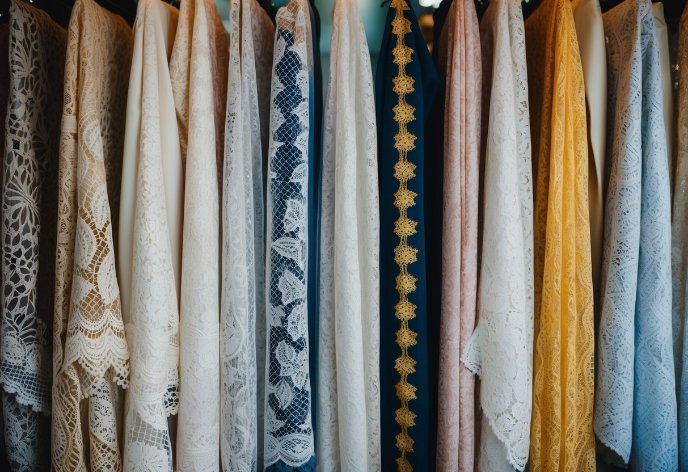
Lace fabrics come in distinct varieties based on their production methods and design characteristics. Handmade and machine-made laces offer unique qualities that suit different applications in fashion and textiles.
Handmade Lace Varieties
Needle lace stands as one of the most intricate handmade varieties, created using a single needle and thread to form detailed patterns. The technique produces exceptionally fine, delicate designs.
Bobbin lace involves weaving multiple threads wound on bobbins to create complex patterns. Skilled artisans manipulate these bobbins around pins on a special cushion to form the design.
Venetian lace features raised, three-dimensional patterns with distinctive floral motifs. This style often incorporates detailed relief work and elaborate borders.
Machine-Made Lace
Lyon lace represents traditional French manufacturing techniques, producing about 35 centimetres per hour. It frequently features floral patterns and can incorporate beading and pearls.
Nylon lace offers affordability and durability. It comes in both straight and scalloped edges, maintaining a delicate appearance despite its synthetic nature.
Cotton lace provides a softer feel than synthetic varieties. Its natural fibres make it ideal for garments that need to conform to body shape.
Innovations in Lace Design
Modern lace manufacturing combines traditional patterns with new materials. Designers now incorporate metallic threads and sustainable fibres into classic designs.
Digital design tools enable precise pattern creation and faster production cycles. This technology allows for intricate customisation while maintaining quality.
Smart textiles integration brings new possibilities to lace design. Some innovative laces now feature embedded electronics for light-up effects or temperature regulation.
Lace-Making Techniques
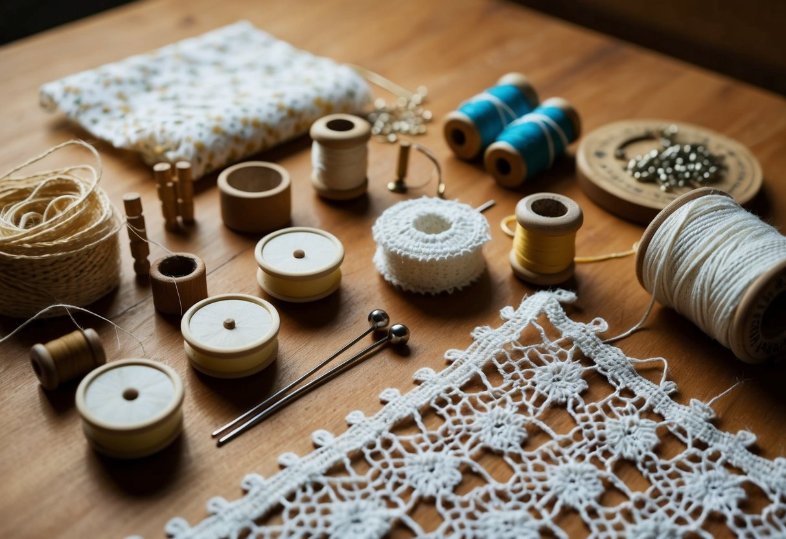
Lace-making involves intricate handwork methods that create delicate patterns through the manipulation of threads. Each technique produces unique textures and designs that serve different decorative purposes.
Traditional Methods
Bobbin lace making requires multiple threads wound on wooden bobbins. The threads are crossed and twisted on a padded pillow to form complex patterns.
Needle lace uses a single thread and needle to create stitches in the air, building up the pattern one tiny section at a time. This method produces extremely fine, detailed work.
Irish crochet lace demands a very fine steel hook, typically 1.00mm to 1.75mm in size, and creates distinctive raised motifs.
Tatting creates durable lace using a small shuttle or needle to form rings and chains of knots. The technique produces a strong, knotted lace perfect for edgings.
Contemporary Practices
Modern lace makers often combine traditional techniques with new materials and tools. Machine-made lace now supplements handmade pieces for everyday use.
Digital design software helps create precise patterns before the physical work begins. This saves time and allows for more complex designs.
Synthetic threads and modern tools make lace-making more accessible to beginners. These materials are often more durable and less expensive than traditional options.
Adult education programmes have evolved to teach these skills, though formal training opportunities have decreased in recent years.
Lace Applications in Garments and Accessories
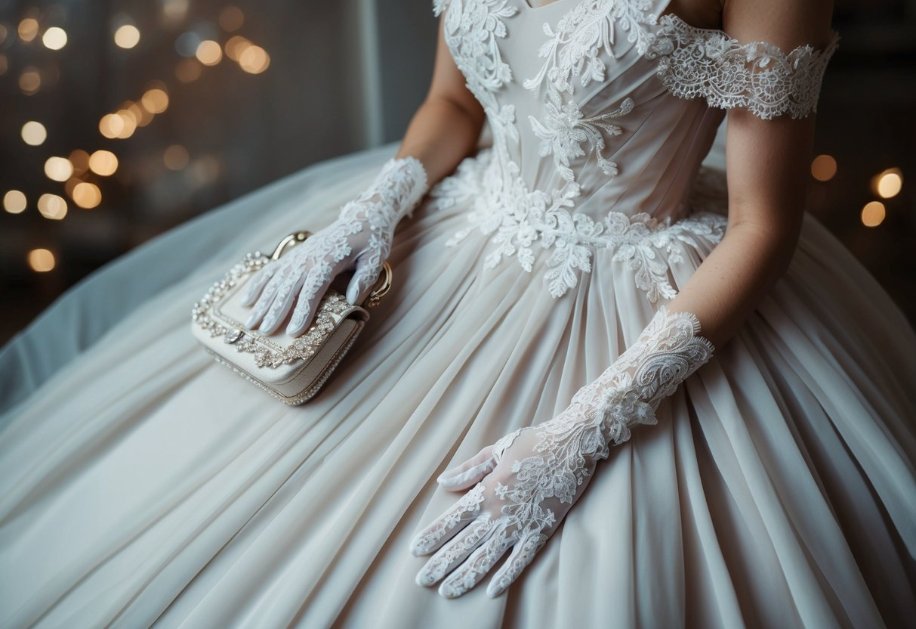
Lace fabric brings elegance and sophistication to clothing and fashion items. The versatile material transforms ordinary garments into stunning pieces through expert craftsmanship and design.
Bridal Wear and Evening Gowns
Wedding gowns showcase lace’s romantic qualities through detailed patterns and delicate overlays. A-line and mermaid-style dresses often feature Chantilly lace bodices with scalloped edges.
Evening gowns utilise lace panels and inserts to create dramatic effects. Designers incorporate sheer lace sleeves and backs to add visual interest while maintaining modesty.
Popular bridal lace applications:
- Full lace overlays
- Lace-trimmed veils
- Detailed bodices
- Sleeve embellishments
Lingerie and Day-to-Day Fashion
Lingerie makers value lace for its delicate appearance and flexibility. Bras and knickers feature stretchy lace panels that provide both comfort and style.
Casual wear incorporates lace through:
- Blouse yokes and panels
- T-shirt inserts
- Dress overlays
- Cardigan edging
Modern fashion designers blend lace with contemporary fabrics to create wearable pieces suitable for work and social occasions.
Decorative Accents and Trims
Lace trims enhance necklines, hemlines and sleeve edges. Small lace appliqués add subtle decoration to plain garments.
Accessories benefit from lace detailing:
- Hair accessories
- Gloves
- Scarves
- Handbag embellishments
Fine lace borders finish handkerchiefs and table linens with refined elegance. Clothing makers use decorative lace elements to create visual interest through texture and pattern contrasts.
Lace in Home Decor
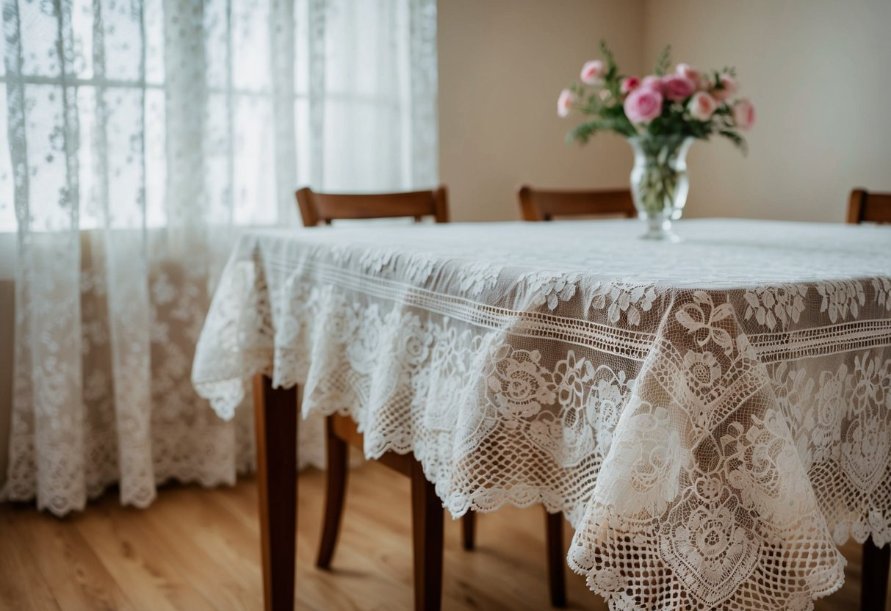
Lace fabric adds elegance to interior spaces through its delicate patterns and timeless appeal. Its versatility allows it to enhance both traditional and modern home settings.
Styling Interiors with Lace
Lace brings charm to lampshades, tablecloths, curtains, and pillows. The soft texture creates a cosy and romantic atmosphere in any room.
Small lace doilies placed under vases or decorative items add a subtle Victorian touch to coffee tables and sideboards.
Popular Lace Patterns for Home Decor:
- Floral motifs for traditional spaces
- Geometric patterns for modern interiors
- Scalloped edges for window treatments
- Fine mesh designs for light filtering
Layering different lace patterns creates visual interest. White or cream lace works well in most colour schemes, whilst coloured lace can serve as an accent piece.
Care and Maintenance of Lace Decor
Proper care keeps lace decor items looking pristine. Hand washing in cool water with mild soap preserves the fabric’s integrity.
- Avoid direct sunlight to prevent yellowing
- Store flat or rolled to maintain shape
- Spot clean spills immediately
- Air dry away from heat sources
Regular gentle vacuuming with a soft brush attachment removes dust from lace curtains and doilies. For delicate pieces, use a soft cloth to pat away dirt.
Rotate lace decor items seasonally to prevent wear in high-traffic areas. Consider professional cleaning for antique or valuable pieces.
Maintaining Lace Fabric
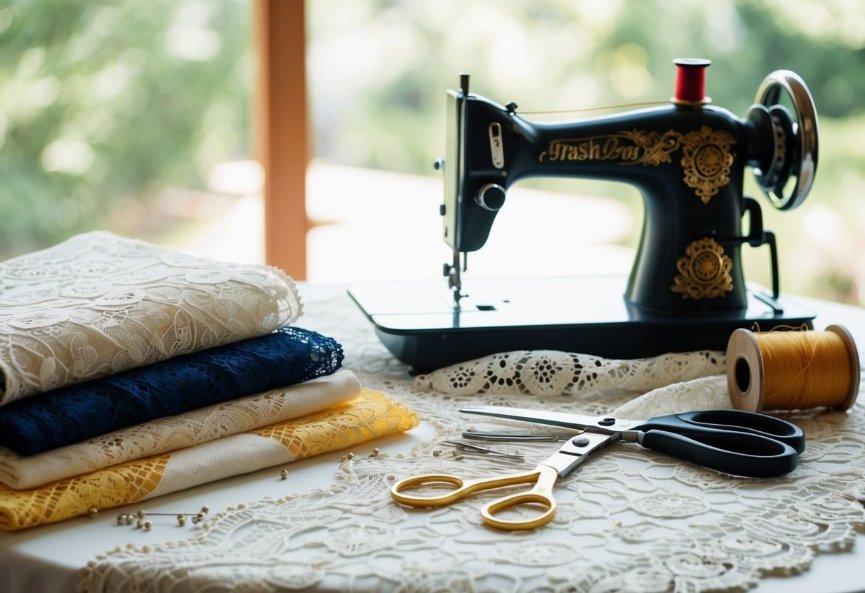
Proper care extends the life of lace fabrics and keeps them looking their best. The right cleaning methods and storage practices make a big difference in preserving these delicate textiles.
Cleaning Techniques
Mild detergents designed for delicate fabrics are essential for cleaning lace. Never use harsh chemicals or fabric softeners.
Hand washing is the safest method. Fill a basin with lukewarm water and add the gentle detergent. Submerge the lace and softly squeeze the soapy water through it.
For machine washing, place items in a mesh bag and use the delicate cycle. Cold or lukewarm water works best.
Avoid harsh scrubbing, which can damage the delicate fibres. Let the soap do the work.
Preservation Tips
Always air dry lace flat on a clean white towel. Never wring or twist the fabric.
Storage dos and don’ts:
- Do store flat in acid-free tissue paper
- Don’t hang heavy lace items
- Do keep away from direct sunlight
- Don’t store in plastic bags
Iron lace only when necessary, using the lowest heat setting. Place a pressing cloth between the iron and lace to protect the fibres.
Regular maintenance helps prevent permanent damage. Check for loose threads or weak spots and address them promptly.
Identifying and Purchasing Quality Lace
Quality lace requires careful inspection of patterns, materials, and construction techniques to ensure you select a premium product worth the investment.
Characteristics of Premium Lace
High-quality lace features uniform stitching and clear, crisp patterns. The edges should be well-defined with smooth scalloping.
Premium lace demonstrates excellent draping qualities and feels soft to touch. When held up to light, the pattern should be clear and consistent.
Look for these key indicators:
- Even thread tension throughout
- Clean, precise pattern edges
- Sturdy yet flexible texture
- Smooth transition between motifs
The edge and scalloping are crucial quality markers. High-end laces like Brussels or Alençon feature intricate borders with firm, neat picot trim.
Shopping Guide for Consumers
Check trademarks and labels from established manufacturers. Reputable brands typically produce more reliable products.
When examining lace in person:
- Hold it against light to check pattern clarity
- Gently stretch to test elasticity
- Feel for consistent thickness
- Inspect for loose threads or gaps
Different types suit various needs. Cotton lace works well for vintage-style garments, whilst Guipure lace creates dramatic formal wear. Venice lace offers durability for decorative items.
Pricing varies significantly based on material and construction method. Machine-made polyester lace costs less than handmade Brussels lace, but both can be appropriate depending on the project.
The Global Influence of Lace
Lace manufacturing spread from Europe to become a significant part of textile traditions worldwide. Its elegant patterns and delicate craftsmanship transformed fashion, cultural ceremonies, and design across continents.
Lace in International Fashion
Lace gained prominence in high fashion across multiple cultures and regions. During the 19th century, Nottingham became the global manufacturing capital of lace, supplying fashion houses worldwide.
The American fashion industry embraced lace production, with 54 lace mills employing 5,000 people and generating substantial revenue through domestic manufacturing.
Modern fashion designers incorporate lace in various ways:
- Wedding gowns and formal wear
- Ready-to-wear collections
- Accessories and trim
- Haute couture pieces
Cultural Significance and Uses
Different cultures adapted lace for their unique traditions and ceremonial garments. Religious ceremonies often feature lace in sacred vestments and altar cloths.
Traditional uses of lace include:
- Ceremonial clothing: Christening gowns, wedding veils
- Home décor: Tablecloths, curtains, doilies
- Special occasions: Family heirlooms, cultural celebrations
Today, sustainable and eco-friendly lace production reflects changing cultural values. New techniques preserve traditional patterns while meeting modern environmental standards.
Frequently Asked Questions
Lace remains a cornerstone of fashion and design, with specific characteristics that make it ideal for various applications. Proper selection requires attention to material composition, construction methods, and intended use.
What are the primary uses of lace in fashion and design?
Lace has maintained its status as a key element in bridal wear and formal attire through centuries of fashion evolution.
Fashion designers regularly incorporate lace details into contemporary collections to add elegance and texture to garments.
Lace serves decorative purposes in home décor, including curtains, table linens, and ornamental trim work.
What should beginners know about choosing lace wigs?
Accurate measurements are essential for achieving a proper fit with any lace wig application.
The lace colour should match the wearer’s skin tone for a natural-looking hairline.
Synthetic lace wigs require different care methods compared to human hair versions.
What distinguishes silk lace from other types of lace?
Silk lace offers superior softness and a natural sheen that synthetic materials cannot replicate.
The fibres in silk lace create a more delicate and refined appearance.
Silk lace typically commands higher prices due to its premium material quality and craftsmanship.
What are the defining characteristics of lace fabric?
Lace features intricate patterns created through the interweaving or knotting of threads.
The open, web-like structure distinguishes lace from other textiles.
Quality lace displays even stitching and clearly defined motifs throughout the material.
How is lace produced and what are the common varieties?
Machine-made lace utilises computerised systems to create precise, uniform patterns.
Hand-made lace, including traditional macramé techniques, requires skilled craftspeople and specialised tools.
Modern manufacturing methods include chemical lace, embroidered lace, and knitted lace varieties.
What factors should be considered when selecting a lace front wig?
The density of the lace affects both durability and appearance of the finished style.
Pre-plucked hairlines create more natural-looking results than uniform edges.
The lace grade impacts both comfort and visual authenticity of the wig.

